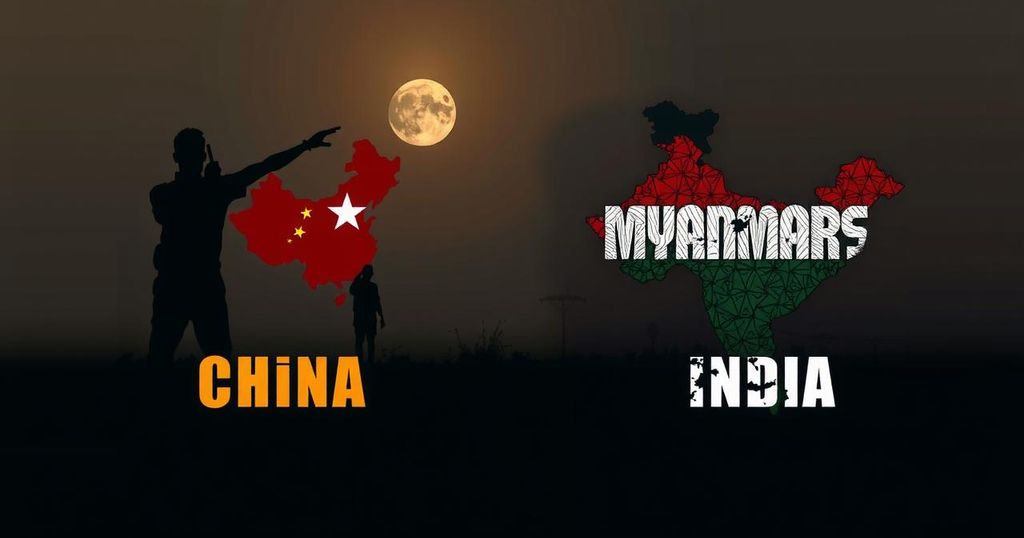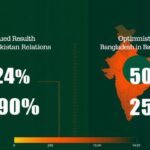China and India’s Perspectives on Myanmar’s Unrest
Summary
Myanmar is currently experiencing a significant political crisis following the military coup in 2021, leading to intensified civil conflict. China has continued to engage with both the junta and rebel groups, prioritizing its investments and regional stability. In contrast, India, while concerned about the implications for its Northeastern region and potential refugee inflows, has chosen a cautious approach, focusing on border security and avoiding favoritism.
Myanmar has been grappling with a profound political crisis since the military ousted Aung San Suu Kyi’s government in 2021. The situation has escalated, with escalating violence between the military junta and insurgent groups. Amid these developments, China has pursued a strategy of close engagement with the junta while managing relations with the opposition factions. Recent interactions, including a meeting between Chinese Ambassador Ma Jia and Myanmar’s defense minister, emphasized strengthening military collaboration and border security. China remains one of the few nations continuing to invest in Myanmar despite the coup and international sanctions, accounting for 25% of the total foreign investment. Beijing’s commitment to infrastructure, port, and energy projects worth $22 billion underscores its vested interests, particularly as Myanmar serves as a crucial link to the Indian Ocean region. In August, China’s Foreign Minister Wang Yi visited Myanmar, aiming to mediate discussions between the junta and rebel groups, extending offers of interest-free loans, and promising assistance for census and election processes. Wang asserted, “China firmly supports Myanmar in maintaining its independence, sovereignty, national unity, and territorial integrity.” Despite these diplomatic efforts, the subsequent military exercises near the Myanmar border indicate that traditional methods have yet to yield the desired outcomes. Live fire drills conducted by China signal its readiness to demonstrate military strength and secure its interests against potential threats from insurgents. In addition to military capabilities, China has employed economic measures to demand peace, threatening to halt cross-border trade due to rebel control over border areas. For Myanmar’s junta, trade is vital for revenue, especially against the backdrop of a troubling economic outlook that forecasts just 1% growth amid the civil turmoil. China’s focus on stabilizing Myanmar stems from its significant investments and concerns over the potential for unrest spilling into its territory. India, similarly invested in Myanmar, views the unrest as a challenge to its Act East Policy, vital for the economic development of its Northeastern states. With the ongoing situation, India confronts the prospect of refugee inflows from Myanmar. Consequently, restoring peace and democratic governance is crucial for India, which has opted for a strategy that emphasizes border security to manage migration rather than military involvement. While India’s cautious approach seeks to balance relations, it risks neglecting the humanitarian crisis unfolding across its borders. New Delhi’s engagement with Myanmar remains essential to prevent further deterioration of the situation, thereby benefiting all parties involved.
The political landscape in Myanmar has been significantly altered since the military coup in February 2021, which displaced the democratically elected government led by Aung San Suu Kyi. The country has since been embroiled in a violent struggle, with numerous ethnic and rebel groups challenging the military’s authority. This ongoing conflict has drawn attention from neighboring countries, particularly China and India, due to their strategic interests and concerns over regional stability. China has prioritized maintaining its investments and borders, while India is tasked with addressing security challenges and humanitarian issues arising from the unrest. Both nations must navigate a complex diplomatic landscape while addressing the key factors contributing to Myanmar’s instability.
In summary, Myanmar’s deepening crisis represents a significant challenge for both China and India, reflecting their respective investments and interests in the region. China’s approach has evolved to include both military demonstrations and economic pressure to ensure stability, while India focuses on managing the consequences of unrest, notably refugee flows, and maintaining a delicate diplomatic position. Both nations have vital stakes in Myanmar’s future, indicating the need for a collaborative effort to restore peace and support sustainable governance in the troubled nation.
Original Source: www.deccanherald.com








Post Comment